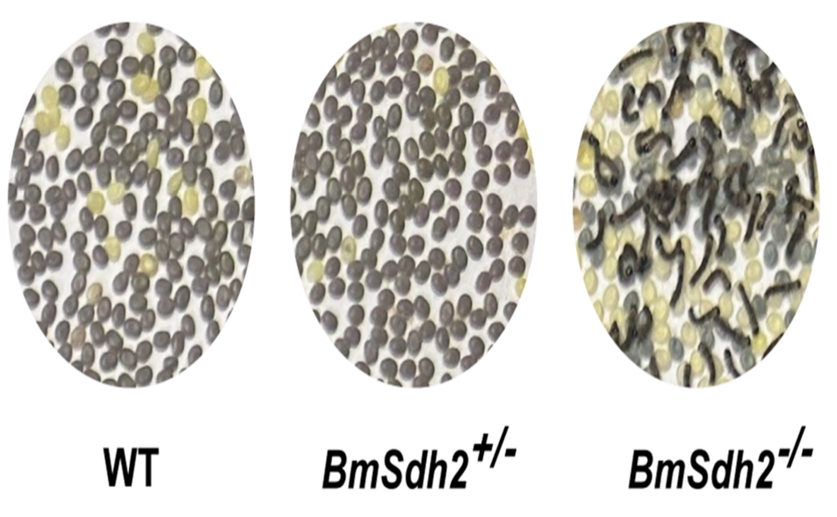Jenn Hoskins
2nd November, 2025

Silkworm eggs from wild-type (WT) and heterozygous mutants (BmSdh2+/-) remain in a dormant state, while eggs from homozygous mutants lacking the BmSdh2 gene (BmSdh2-/-) bypass this arrest and hatch into larvae.
Key Findings
- This study, conducted on silkworms, identified a key enzyme, BmSdh2, as crucial for maintaining embryonic diapause—a dormant state for surviving unfavorable conditions
- Removing BmSdh2 entirely caused silkworm embryos to prematurely end diapause, showing the enzyme’s dosage is critical for the dormant state
- Altering BmSdh2 levels impacted energy storage within silkworm embryos, linking the enzyme to both carbohydrate and lipid metabolism during diapause
Researchers from Shanghai Jiao Tong University, Shenyang Agricultural University, and the University of Kentucky[1] have recently identified a key enzyme, sorbitol dehydrogenase (SDH), specifically a variant called BmSdh2, as a critical regulator of diapause in silkworms. Previous research established that diapause in silkworms is controlled by a hormone called diapause hormone (DH) and its receptor[2]. This hormone initiates a signaling cascade, but the detailed steps downstream of this initial signal were not fully understood. Recent work has begun to map out the genes affected by DH signaling, revealing changes in genes related to energy metabolism, detoxification, and even epigenetic modifications – changes to how genes are expressed without altering the underlying DNA sequence[3].
The current study began with an analysis of gene activity in silkworm embryos destined to enter diapause, using a technique called RNA-seq, which measures the levels of different RNA molecules, providing a snapshot of gene expression. This revealed that the gene for BmSdh2 was highly active in these embryos. Sorbitol dehydrogenase is an enzyme involved in carbohydrate metabolism, specifically the conversion of sorbitol to fructose.
To determine the role of BmSdh2 in diapause, the researchers genetically manipulated its expression. They created silkworms with a complete knockout of the BmSdh2 gene – meaning the gene was non-functional – and others with reduced, but not absent, function. The results were striking: completely removing BmSdh2 caused the silkworm embryos to exit diapause prematurely. However, reducing the amount of functional BmSdh2 didn’t disrupt diapause, maintaining it as normal. This suggests that a certain level of BmSdh2 activity is crucial for maintaining the dormant state.
To understand how BmSdh2 influences diapause, the researchers performed detailed analyses of the chemical composition of the embryos, using techniques like LC-MS/MS (liquid chromatography-mass spectrometry) for metabolomics – the study of small molecules – and lipidomics – the study of fats. These analyses showed that the amount of BmSdh2 present directly affected the levels of various metabolites and lipids within the embryos. Specifically, altering BmSdh2 levels changed the balance of compounds involved in energy production and storage.
This study builds on earlier findings that insects accumulate energy reserves, particularly fats, before entering diapause[4]. The energy stored is then used to sustain them through the dormant period. The research suggests that BmSdh2 plays a role in managing these energy reserves, ensuring that the embryo has the necessary resources to maintain diapause and successfully resume development when conditions improve. The precise link between BmSdh2, sorbitol metabolism, and the downstream effects on energy reserves is still being investigated, but this work identifies BmSdh2 as a central regulator of the silkworm diapause pathway.
References
Main Study
1) Dosage-dependent regulation of embryonic diapause by sorbitol dehydrogenase in the silkworm, Bombyx mori
Published 30th October, 2025
https://doi.org/10.1371/journal.pgen.1011933
Related Studies
4) Meeting the energetic demands of insect diapause: nutrient storage and utilization.
Journal: Journal of insect physiology, Issue: Vol 53, Issue 8, Aug 2007
Related Articles

